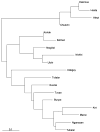Mitochondrial DNA diversity in indigenous populations of the southern extent of Siberia, and the origins of Native American haplogroups
- PMID: 15638829
- PMCID: PMC3905771
- DOI: 10.1046/j.1529-8817.2003.00127.x
Mitochondrial DNA diversity in indigenous populations of the southern extent of Siberia, and the origins of Native American haplogroups
Abstract
In search of the ancestors of Native American mitochondrial DNA (mtDNA) haplogroups, we analyzed the mtDNA of 531 individuals from nine indigenous populations in Siberia. All mtDNAs were subjected to high-resolution RFLP analysis, sequencing of the control-region hypervariable segment I (HVS-I), and surveyed for additional polymorphic markers in the coding region. Furthermore, the mtDNAs selected according to haplogroup/subhaplogroup status were completely sequenced. Phylogenetic analyses of the resulting data, combined with those from previously published Siberian arctic and sub-arctic populations, revealed that remnants of the ancient Siberian gene pool are still evident in Siberian populations, suggesting that the founding haplotypes of the Native American A-D branches originated in different parts of Siberia. Thus, lineage A complete sequences revealed in the Mansi of the Lower Ob and the Ket of the Lower Yenisei belong to A1, suggesting that A1 mtDNAs occasionally found in the remnants of hunting-gathering populations of northwestern and northern Siberia belonged to a common gene pool of the Siberian progenitors of Paleoindians. Moreover, lineage B1, which is the most closely related to the American B2, occurred in the Tubalar and Tuvan inhabiting the territory between the upper reaches of the Ob River in the west, to the Upper Yenisei region in the east. Finally, the sequence variants of haplogroups C and D, which are most similar to Native American C1 and D1, were detected in the Ulchi of the Lower Amur. Overall, our data suggest that the immediate ancestors of the Siberian/Beringian migrants who gave rise to ancient (pre-Clovis) Paleoindians have a common origin with aboriginal people of the area now designated the Altai-Sayan Upland, as well as the Lower Amur/Sea of Okhotsk region.
Figures




References
-
- Andrews RM, Kubacka I, Chinnery PF, Lightowlers RN, Turnbull DM, Howell N. Reanalysis and revision of the Cambridge reference sequence for human mitochondrial DNA. Nat Genet. 1999;23:147. - PubMed
-
- Black LT. Peoples of the Amur and maritime regions. In: Fitzhugh WW, Crowell A, editors. Crossroads of continents: cultures of Siberia and Alaska. Smithsonian Institution Press; Washington, DC: 1988. pp. 24–31.
Publication types
MeSH terms
Substances
Grants and funding
LinkOut - more resources
Full Text Sources
Molecular Biology Databases
Miscellaneous

